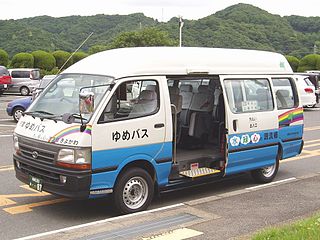
Minivan is a car classification for vehicles designed to transport passengers in the rear seating row(s), with reconfigurable seats in two or three rows. The equivalent classification in Europe is MPV or M-segment.

A van is a type of road vehicle used for transporting goods or people. Depending on the type of van, it can be bigger or smaller than a pickup truck and SUV, and bigger than a common car. There is some variation in the scope of the word across the different English-speaking countries. The smallest vans, microvans, are used for transporting either goods or people in tiny quantities. Mini MPVs, compact MPVs, and MPVs are all small vans usually used for transporting people in small quantities. Larger vans with passenger seats are used for institutional purposes, such as transporting students. Larger vans with only front seats are often used for business purposes, to carry goods and equipment. Specially equipped vans are used by television stations as mobile studios. Postal services and courier companies use large step vans to deliver packages.

A station wagon or estate car, is an automotive body-style variant of a sedan with its roof extended rearward over a shared passenger/cargo volume with access at the back via a third or fifth door, instead of a trunk/boot lid. The body style transforms a standard three-box design into a two-box design—to include an A, B, and C-pillar, as well as a D-pillar. Station wagons can flexibly reconfigure their interior volume via fold-down rear seats to prioritize either passenger or cargo volume.

Eagle was a brand of the Chrysler Corporation following the purchase of American Motors Corporation (AMC) in 1987 and marketed through the end of the 1998 model year. It was aimed at the enthusiast driver and promoted as more "European" than the automaker's similar models.

A hatchback is a car body configuration with a rear door that swings upward to provide access to the main interior of the car as a cargo area rather than just to a separated trunk. Hatchbacks may feature fold-down second-row seating, where the interior can be reconfigured to prioritize passenger or cargo volume.
Governments and private organizations have developed car classification schemes that are used for various purposes including regulation, description, and categorization of cars.

The Mazda MPV is a minivan manufactured by Mazda. Introduced in 1988 as a rear-wheel-drive model with optional selectable four-wheel drive, this was replaced in 1999 with a front-wheel-drive version with optional all-wheel-drive in some markets. Over one million MPV models have been produced since its introduction.

The Eagle Summit is a line of subcompact cars produced for two generations by Mitsubishi and sold by Eagle from 1989 until 1996. It was marketed as a captive import by the Jeep-Eagle sales division that was established after Chrysler Corporation purchased American Motors Corporation (AMC) in 1987.

The Mercury Villager is a minivan that was marketed by Mercury from 1993 to 2002. Taking its name used by Mercury to denote its wood-trimmed station wagons, the Villager was developed in a joint venture between Ford and Nissan; the latter manufacturer marketed the line as the Nissan Quest. The first front-wheel drive van produced by Ford, the Mercury Villager was introduced between the Ford Aerostar and the Ford Windstar, competing against Chrysler minivans and the General Motors APV minivans.

A crossover, crossover SUV, or crossover utility vehicle (CUV) is a type of automobile with an increased ride height that is built on unibody chassis construction shared with passenger cars, as opposed to traditional sport utility vehicles (SUV), which are built on a body-on-frame chassis construction similar to pickup trucks.

The Nissan Prairie is an automobile manufactured and marketed by Nissan from 1981 to 2004. Considered a mini MPV or a compact MPV. It was also marketed as the Multi in Canada and the Stanza Wagon in the United States. In Japan, it was exclusive to Nissan Bluebird Store locations, then later at Nissan Blue Stage sales channels. The Prairie had a very flexible seating capability and sliding rear doors on both sides of the vehicle, with a liftgate in the back. The name "prairie" was derived from French which means an extensive area of relatively flat grassland, similar to "steppe" or "savanna".

The Mitsubishi Chariot is an automobile manufactured and marketed by Mitsubishi from 1983 to 2003. It is a small multi-purpose vehicle (MPV). Based on the SSW concept car first exhibited at the 23rd Tokyo Motor Show in 1979, the MPV derives its nameplate from chariots used by the ancient Greek and Roman empires.

The Nissan Quest is a minivan manufactured and marketed by Nissan for model years 1993–2017 over four generations.

The Eagle Medallion, also marketed as the Renault Medallion, is a rebadged and mildly re-engineered North American version of the French Renault 21 marketed by American Motors Corporation under the Renault brand for the 1988 model year, and by Chrysler's Jeep/Eagle division for the 1989 model year.

Mini MPV—an abbreviation for mini multi-purpose vehicle—is a vehicle size class for the smallest size of minivans/MPVs. The mini MPV size class sits below the compact MPV size class and the vehicles are often built on the platforms of B-segment hatchback models. By the European definition, the mini MPV commonly consists of cars with two rows of seats, while in Asia mini MPVs with three rows are common. Sliding doors are sometimes also fitted to mini MPVs. Mini MPVs are also called tall-hatchbacks or small MPVs.

The Mitsubishi RVR is a range of cars produced by Japanese manufacturer Mitsubishi Motors from 1991 to 2002 and then from 2010 until present. The first two generations were classified as compact multi-purpose vehicles (MPV), and the model introduced in 2010 is a subcompact crossover SUV.

A microvan is a van or minivan which is within the Japanese kei car classification or similar, and is smaller than a mini MPV. In China, these vehicles are nicknamed miàn bāo chē because of their shape. Similarly, in several Hispanic American countries, these vehicles are called pan de molde, which means "bread loaf". In Indonesia, it is commonly called a minibus due to their tall roof, perceived as resembling a miniature bus; the term is also used generally to refer to any type of three-row MPVs.

A sliding door is a type of door that is mounted on or suspended from a track for the door to slide, usually horizontally and outside. It is a feature predominantly found in minibuses, buses, and vans, so as to allow a large unobstructed access to the interior for loading and unloading of passengers or cargo without the doors interfering with adjacent space.

The Mazda Premacy is a passenger minivan that was built by the Japanese manufacturer Mazda from 1999 to 2018.

The third-generation Chrysler minivans are a series of passenger minivans that were marketed by the Chrysler Corporation from the 1996 to 2000 model years. The first ground-up redesign of the model lines since their introduction, designers added a further degree of divisional identity between the Plymouth Voyager, Dodge Caravan, and Chrysler Town & Country. In a notable change, the cargo van was discontinued, with all examples sold as passenger vans. Coinciding with the retirement of the Plymouth brand during 2001, this is the final generation marketed as the Plymouth Voyager.





















